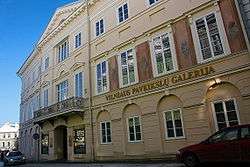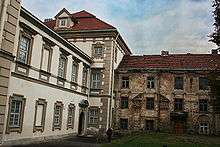Lithuanian Art Museum


The Lithuanian Art Museum was initially established in Vilnius in 1933 as the Vilnius City Museum. It houses Lithuania's largest art collection.
History
The institution's origins can be traced to the early 20th century, when a resurgence of cultural interest followed the end of the ban on the Lithuanian language imposed by the Russian Empire. A number of art exhibitions at that time donated works to the Lithuanian Art Society, which began to make plans for a permanent facility. The activity was interrupted by World War I.
During the postwar era, the plans were restarted. In 1933, the Vilnius Magistracy, an administrative division of the Polish government that controlled Vilnius at the time, decided to establish a City Museum. Works of art were collected and stored in various buildings, but were not accessible to visitors. In April 1941, its first exhibitions were held; it was known at the time as the Vilnius State Art Museum. In January 1997, the new government of Lithuania granted the museum its current status as a national museum; it is now part of the Ministry of Culture.
Branches


The museum's branches consist of the National Art Gallery in Vilnius; the Picture Gallery in Vilnius' Chodkevičiai Palace; the Museum of Applied Art at the Vilnius Castle Complex; the Radziwiłł Palace in Vilnius; the Palanga Amber Museum; the Pranas Domšaitis Gallery in Klaipėda; the Clock Museum in Klaipėda; and the Exhibition Hall in Juodkrantė.
Collections
The collections at the museum include about 2,500 paintings dated from the 16th to the 19th Century; these consist mostly of portraits of nobility and clergy of the Lithuanian Grand Duchy from the 16th to the 18th centuries, and religious works from Lithuanian churches and cloisters. Over 8,000 drawings by Italian, German, French, Flemish, Dutch, Polish, English, and Japanese artists from the 15th to the 20th century are represented.
The first half of the 20th century has an extensive presence, with over 12,000 works. The collection from the second half of the 20th century features more than 21,000 exhibits. Sculpture collections span the 14th through 20th centuries, with works from a number of European countries. Other notable collections include works done in watercolor and pastel, and photography.
References
External links
![]() Media related to Lithuanian Art Museum at Wikimedia Commons
Media related to Lithuanian Art Museum at Wikimedia Commons
![]() Media related to National Museum of Lithuania at Wikimedia Commons
Media related to National Museum of Lithuania at Wikimedia Commons
Coordinates: 54°40′51″N 25°17′24″E / 54.68083°N 25.29000°E